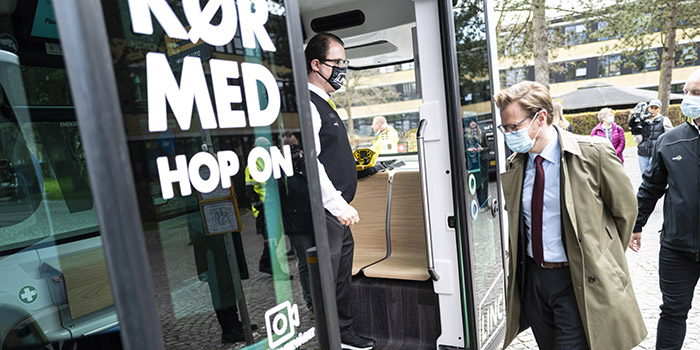Students and staff at DTU in Lyngby can now take an autonomous shuttle when going around campus. They share their experiences with the researchers behind the project, so the self-driving technology can be better integrated into public transport.
Silently, the autonomous shuttle starts. With connection to satellites and equipped with sensors that see other road users or obstacles, the shuttle forms an overview and navigates safely around DTU Lyngby Campus. But how do the passengers feel about the driver-less transport of tomorrow? And how can an autonomous shuttle become part of our public transport? The LINC project partners will examine these questions—with the assistance of students and staff.
“We’ve been excited about getting to test the shuttle, so that—in future—we can provide citizens with an additional public transport service. We imagine that the autonomous shuttle is a good supplement to—for example—the coming Greater Copenhagen Light Rail system. With the shuttle, passengers can finish the last part of their journey from the station to work, studies, or home,” says Kenneth Jørgensen, Senior Project Manager for LINC in Gate 21.
In addition to the Gate 21 partnership, Municipality of Albertslund, Municipality of Gladsaxe, Nobina Danmark, IBM Danmark, Roskilde University (RUC), and DTU participate in the project. The partners are now starting to collect data from the passengers at DTU.
Test passengers to share their experiences
Students and staff can register as test passengers. This means that—during the test period until summer 2021—they can use the shuttle for free and must fill in a number of questionnaires prepared by RUC and DTU, among others:
“We need to examine the interaction between humans and the self-driving technology. How do we react to it? Do we feel safe? Does this transport type work in our day-to-day lives?,” says Hannah Villadsen, PhD and Postdoc at the Department of People and Technology at Roskilde University (RUC) and continues:
“The test at DTU is obviously a slightly ‘artificial reality’, as we are not allowed to drive all that fast and because there is a steward on board. But the test passengers’ input is crucial in understanding how we can use the technology in the future.”
App links data and tracks test passengers’ movements
DTU Compute has developed an app solution for the project. It links data from the questionnaires with data on the test passengers’ movements on campus, obtained via GPS and Bluetooth beacons set up at stops, in the shuttle, and in buildings near the route at DTU.
“We’ve taken the app one step further than others. It’s not just a tracking app where we can see how many have taken the autonomous shuttle. We can actually use it as a tool and integrate it with a questionnaire. Using Bluetooth beacons, we can analyse data more accurately while passengers are on the go. Hopefully, this can give us even more detailed insight into their transport patterns,” says Per Bækgaard, Associate Professor at DTU Compute.
The app is the result of large-scale development and data collection work performed in IBM Cloud. In collaboration with DTU, IBM Danmark has developed various functionalities that can display data to the researchers and send special surveys via the app—so-called event-triggered surveys—directly to the test passengers in situations that may arise:
“For example, this may be in connection with a sudden emergency stop, where we have the opportunity via the app directly to ask the test passengers present about their experience on the shuttle. This allows us to get quick feedback in the given situation. It’s a completely unique way of obtaining data about our public transport that does not otherwise exist today,” says Claus Klint, Director Internet of Things, IBM Danmark.
The public transport form of tomorrow based on current knowledge
Bus operator Nobina Danmark—which has been granted the test permit and is responsible for operating the autonomous shuttles at DTU—welcomes the data collected through the project:
“The input from the students and staff at DTU helps shape how we can offer a new collective service to the citizens in the future. In LINC, we’re working with the concept that the autonomous shuttles can be linked to the stations of the coming Greater Copenhagen Light Rail system, thus strengthening and increasing the extent of public transport services. Autonomous shuttles are a dynamic supplement to the existing transport forms that run along fixed routes and lanes. This gives passengers greater flexibility and can bring them closer to their destination,” says Rasmus Noes, Head of Market and Business Development in Nobina Danmark.
The three autonomous LINC shuttles will run at DTU Lyngby Campus until the 2021 summer holidays. The LINC project is funded by the partners and the EU programme Urban Innovative Actions.
At an event held at DTU on Friday, 7 May, Minister for Transport Benny Engelbrecht tried the autonomous shuttle: “I’m very excited about everything—including autonomous buses—that can boost public transport and get people to leave their cars at home”.
Photo: Rasmus Degnbol.
